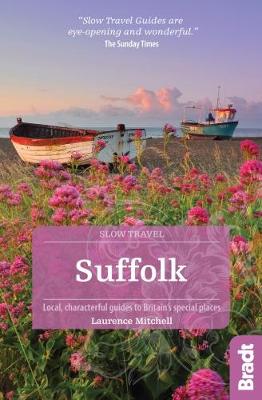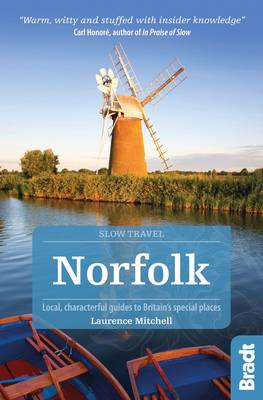Bradt Travel Guides (Slow Travel series)
3 total works
This new second edition of Suffolk, part of Bradt's distinctive Slow series of regional UK guides, remains the only full-blown standalone guide to this gentle but beguiling county. Written by expert local author Laurence Mitchell, this is the guide of choice for anyone wanting to get under the skin of the region and discover what makes it tick. This new edition offers a very personal view of the county, providing up-to-date information on the best places to visit, stay and eat, covering not just popular sights but focusing also on those places beyond the usual tourist trail.
Suffolk's popularity as a destination is not waning, and events such as the Latitude festival in July or the Aldeburgh Music Festival at Britten's Snape Maltings, not to mention the use of the RSPB's Minsmere Reserve as a base for BBC's Springwatch, are all helping to keep the county's profile raised.
Southwold, Aldeburgh, Orford, Walberswick and Dunwich are all covered, as is the great variety of landscapes, from undulating farmland and sandy heaths to extensive forests such as Rendlesham and Thetford in the Brecks, important nature reserves and the soft, dreamy coastal landscapes of river estuaries, remote marshes, reed-beds, beaches, shingle banks, sand spits and dunes.
Also included are Constable Country and the Stour valley, Bury St Edmunds, Framlingham, Bungay, Beccles and Halesworth, plus information on Suffolk's wealth of medieval churches and its Anglo-Saxon heritage, notably the royal ceremonial burial site at Sutton Hoo and the reconstructed Anglo-Saxon village at West Stow.
Bradt's Suffolk makes a virtue of being selective and pointing the reader to the cream of the area. It is organised into locales to encourage 'stay put' tourism, with the opportunity to explore each locale thoroughly. There are also plenty of options for car-free travel: walking, cycling, river boats and local buses and trains. Written in an entertaining style, and offering a personal narrative, authoritative information and interesting anecdotes, Bradt's Suffolk is the ideal companion with which to discover this charming corner of England.
Suffolk's popularity as a destination is not waning, and events such as the Latitude festival in July or the Aldeburgh Music Festival at Britten's Snape Maltings, not to mention the use of the RSPB's Minsmere Reserve as a base for BBC's Springwatch, are all helping to keep the county's profile raised.
Southwold, Aldeburgh, Orford, Walberswick and Dunwich are all covered, as is the great variety of landscapes, from undulating farmland and sandy heaths to extensive forests such as Rendlesham and Thetford in the Brecks, important nature reserves and the soft, dreamy coastal landscapes of river estuaries, remote marshes, reed-beds, beaches, shingle banks, sand spits and dunes.
Also included are Constable Country and the Stour valley, Bury St Edmunds, Framlingham, Bungay, Beccles and Halesworth, plus information on Suffolk's wealth of medieval churches and its Anglo-Saxon heritage, notably the royal ceremonial burial site at Sutton Hoo and the reconstructed Anglo-Saxon village at West Stow.
Bradt's Suffolk makes a virtue of being selective and pointing the reader to the cream of the area. It is organised into locales to encourage 'stay put' tourism, with the opportunity to explore each locale thoroughly. There are also plenty of options for car-free travel: walking, cycling, river boats and local buses and trains. Written in an entertaining style, and offering a personal narrative, authoritative information and interesting anecdotes, Bradt's Suffolk is the ideal companion with which to discover this charming corner of England.
This new, thoroughly updated second edition of Bradt's Norfolk, part of the distinctive 'Slow travel' series of guides to UK regions, remains the only full-blown standalone guide available to this county of contrasts, from the fine medieval city of Norwich to the watery wilderness of the Broads and the sweeping beaches of the superlative north Norfolk coast. As well as featuring all the main sights, Bradt's Norfolk covers places and aspects of the region not detailed by other guidebooks and has a special emphasis on car-free travel, walking, local food and pubs. It also includes personal anecdotes and the views of local people as well as tapping into the Norfolk-based author's considerable knowledge of the region.
Making a virtue of being selective, the guide points visitors to the cream of the area, but includes the whole of Norfolk from Great Yarmouth and the Broads in the east to the Fens of the far west, from the iconic north Norfolk coast to the Breckland region to the south. Places to eat and drink are selected by the author based upon long-standing knowledge of the area, in particular delving into aspects of local distinctiveness and character. Flora and fauna are also covered, detailing the many wildlife sites within the county that are home to rare species, including the iconic Swallowtail butterfly, and information is provided on many of the best birdwatching spots.
Hiking and biking, literary and artistic connections, canoeing and water-based activities, local food and drink, and all the practical information you could need are included, helping to make this the must-have guide for all visitors to this beguiling county. Written in an entertaining style combining personal narrative with authoritative information, Bradt's Norfolk has all the most up-to-date information you could need for a successful visit.
Making a virtue of being selective, the guide points visitors to the cream of the area, but includes the whole of Norfolk from Great Yarmouth and the Broads in the east to the Fens of the far west, from the iconic north Norfolk coast to the Breckland region to the south. Places to eat and drink are selected by the author based upon long-standing knowledge of the area, in particular delving into aspects of local distinctiveness and character. Flora and fauna are also covered, detailing the many wildlife sites within the county that are home to rare species, including the iconic Swallowtail butterfly, and information is provided on many of the best birdwatching spots.
Hiking and biking, literary and artistic connections, canoeing and water-based activities, local food and drink, and all the practical information you could need are included, helping to make this the must-have guide for all visitors to this beguiling county. Written in an entertaining style combining personal narrative with authoritative information, Bradt's Norfolk has all the most up-to-date information you could need for a successful visit.
Slow Norfolk, although selective, includes the whole of Norfolk from Great Yarmouth and the Broads to the east to the Fens of the far west, from the iconic North Norfolk coast to the Breckland region to the south. The Norfolk landscape is far more variable than many imagine and not quite as flat as it is usually reputed to be. The North Norfolk coast, considered to be one of the most beautiful stretches in England, is also a hugely important habitat for wildlife especially migrating birds. The interior of the county tends to be more overlooked yet also much to offer, especially in terms of landscape, historic monuments and characterful market towns. The county has a rich mix of architectural variety, with numerous country houses, medieval churches, Roman forts and Norman castles. The county capital Norwich is an important centre for art and culture, with its acclaimed Sainsbury Centre for Visual Arts and the annual, highly rated Norwich and Norfolk Festival.


